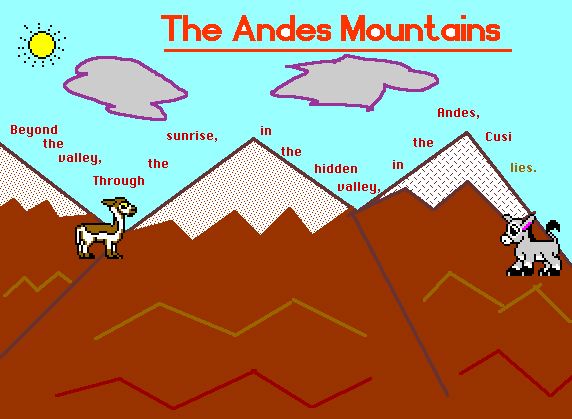
 |
AIMS:
1. We will use computer technology to research different
forms of poetry.
2. Students will become familiar with various forms
of poetry.
3. Students will analyze and evaluate the pattern
and rhythm of a poem as well as the rhyme and sound of a poem.
4. Students will write original poems.
5. Students will cooperatively work with other students
in small group situations and with partners.
6. Students will appreciate the connection between
multicultural literature and creative writing.
GRADE LEVEL: Fifth Grade
ESTIMATED TIME FRAME: 5 class periods
SETTING: Classroom
INTERDISCIPLINARY AREAS: Literature/Creative Writing/Art
MATERIALS:
Novel- Secret of the Andes, by Ann Nolan Clark
Poetry anthologies
Netscape
Claris Works
Visual Aids: Winter scenes, beach scenes,
rain forests scenes, celebration scenes
MOTIVATION:
1. Relate to children's knowledge gained from novel
Secret of the Andes.
-What did we learn about Incan history?
-What journeys did Cusi go on?
-What important lessons did Cusi learn?
2. Display and distribute samples of poetry. (can
you link to a website to find them?)
3. Read aloud various poems to class.
4. Relate to children's experience
-What is your favorite poem?
-Why is this your favorite poem?
5. Brainstorm children's knowledge of poetry characteristics.
PROCEDURE:
1. Introduce vocabulary in context- imagery, simile,
metaphor, rhythm, rhyme, repetition
2. Distribute database on poetry:
| What are five forms of poetry? | sonnet, haiku, quatrain, narrative, free verse |
| What images are captured in haiku poetry? | nature, senses, emotions |
| Identify the four patterns of quatrain poems. | ABAB, ABBA, AABB, AAAA |
| What is narrative poetry? | relates a particular event; tells a story |
| What are the characteristics of free verse poetry? | does not have a definite rhyme; has definite rhythm |
| How does a sonnet express a mood or an idea? | single thought, feeling, or mood in 14 lines |
 |
 |
EVALUATION:
1. Ask following questions-
-How has the computer aided you in your research
on forms of poetry?
-How did the Student Writing Center make writing
your poems easier?
-How did Kid Pix help you create illustrations?
2. Analyze original poems.
3. Check findings from teacher made test on forms
of poetry. (Test questions include:
What is a sonnet? Define Haiku poetry. Define lyric.
Define quatrain. What is narrative poetry? Define free verse.)
FOLLOW-UP:
1. Plan an assembly program around poetry.
2. Let children draw or paint scenes illustrating
poems.
3. Bind collection of poems together and place in
the class library.
4. Send home a newsletter once a month pertaining
to students' original poetry.
HIGHLIGHTS:
Children enjoyed writing and listening to poetry
so much, a listening center was created so children could hear poets reading
their works on tape and also recite and record their own original poems.